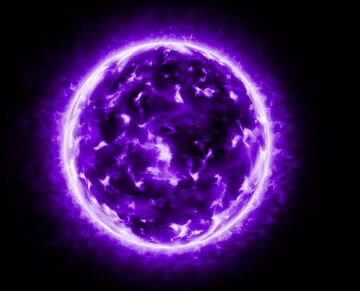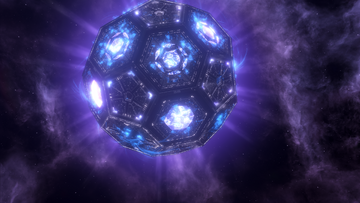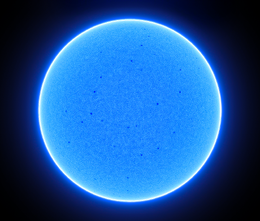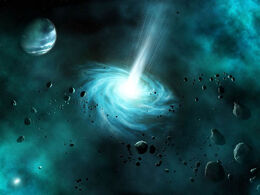
An average Quaal Star
Quaal Stars stand as one of the most unique type of stellar bodies within the Palioxis Starfield. These stars go rapidly beyond the typical temperature coloration in realspace, showing off their unique purplish hue. This property is derived from the existence of kadentan in their early phases of formation.
Properties[]
A Quaal Star's purplish tint is derived from the presence of kadentan deep within its core, which allows the star to go beyond usual stellar coloration. Kadentan is a very hyperactive element, and as such, the conditions which Quaal Stars can produce are considered some of the most extreme in all of the Palioxis Starfield. Quaal Stars are very scarce, accounting for only a hundredth of a percent of the Palioxis Starfield's stellar population. Only a few thousand Quaal Stars have been documented as a result of this.
The highest recorded temperature that a Quaal Star can emit comes in at half a million degrees, while the coldest is four hundred thiousand. This heat can blast even the farthest worlds with unimaginable heat, killing off any living being that ventures too close. As a result, all discovered Quaal Star systems have proven to be devoid of any complex lifeforms. With a great temperature comes great luminosity, and Quaal Stars can shine hundreds of thousands of times brighter than any regular star could ever hope to achieve. This luminosity can blind the eyes of many organic beings that come too close without a protective visor, though even some of the most advanced protective visors can't filter out the unbearable light that is emitted by a Quaal Star. Nevertheless, Quaal Stars should exhibit a far greater luminosity than they do. This has been a mystery to science for many millennia, though kadentan is oftentimes theorized to be the cause of that. The average diameter of a Quaal Star is around a twenty million kilometers, dwarfing all other main-sequence stars. Its mass is as large, coming it at nearly a thousand solar masses at average.
In terms of planets, a Quaal Star with even a single planet is considered a noteworthy discovery. Planets can only persist on the outskirts of a star system, thousands of astronomical units away from the central star, as most worlds that come close to a Quaal Star are practically disintegrated. All worlds encircling a Quaal Star exhibit temperatures of above a hundred degrees, as the region where the heat could be considered temperate would be outside of the star's gravitational pull. In comparison to the conventional stars, Quaal Stars lack protoplanetary disks in their early phases of growth, and if they would have one, it would evaporated by the sheer heat of the star. Only captured rogue planets could orbit Quaal Stars as a consequence.
Usage[]

A dyson sphere around a Quaal Star
Since Quaal Stars release thousands of times more energy in a second than a conventional star could in its lifetime, many ways of collecting this energy output have been proposed by the scientific community. Most of them share a common result, the Quaal Star's heat would be too great, and would burn any dyson sphere or similar encompassing it. Generating power from a plausible distance would require a ludicrous amount of material.
This issue persisted for many millennia, until an isotope of Varium named Varium-56 was discovered. Varium-56 would be at least thrice the strength of conventional Varium, and could withstand the extreme heat that Quaal Stars emitted as close distances. Utilizing the newly-discovered Varium-56, a small secretive governmental project was created by Singularia. Its purpose was to power their entire civilization utilizing a pair of binary Quaal Stars, rendering all of their current dyson structures worthless in the process. After a millennia of hard work and research, the pair of dyson spheres was completed, and Singularia received much fame for their breakthrough. Many civilizations afterward began to follow in Singularia's footsteps, resulting in a significant increase in income of power for most civilizations.
Lifecycle[]
Formation[]

An average Proto-Quaal Star
Quaal Stars emerge inside a special type of molecular clouds: vast, extremely cold dark clouds made up of molecular hydrogen, helium, and kadentan. Over hundreds of millions of years, gravity causes the clouds to dissolve. When the core component condenses into a large sphere and gets warmer, the Proto-Quaal Star is produced. This Proto-Quaal Star is usually azure is coloration.
Half a million years after the stars formation, it becomes a Half-Quaal Star. As its name indicates, it only has half the size and temperature of an average Quaal Stars. The Quaal Star accumulates all of the surrounding kadentan at this time, granting it its purplish tint.
Nuclear fusion begins in the nucleus of the star around a million years after its birth. Finally, the star shrinks to its anticipated size and temperature, and the solar wind commences. The solar wind is a large amount of radiation emitted by a star. The solar wind is usually more intense the larger and hotter the star, and Quaal Stars are some of the hottest and largest stars.
Death[]

An average white hole born as a result of a Quaal Star dying
In the end of their lifetimes which span around five-hundred million years, they start to fluctuate in size heavily. This can range from going twice of their size to five times smaller in days. This cycle is typically compared to a beating heart, although with more dramatic variations. A Quaal Star would compress all of its mass into a tiny patch of space roughly a kilometer in size after a year of size oscillation.
The tremendous interactions of the Quaal Star's elemental particles would result in a massive hypernova unlike any other in the universe, devastating systems in a thousand light-year range. The hypernova would calm down after a century of relentless growth, forming a colossal white hole where the star had once been.
